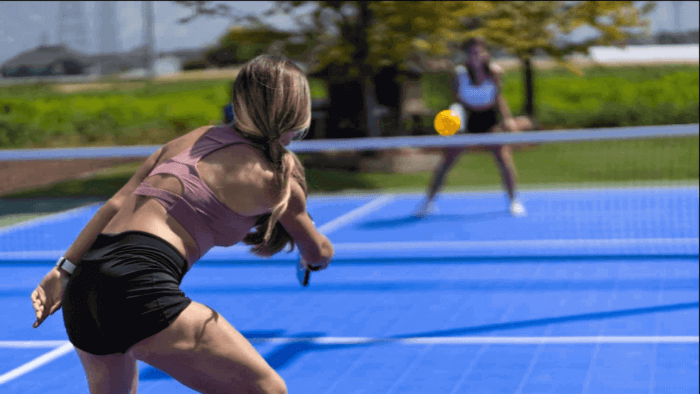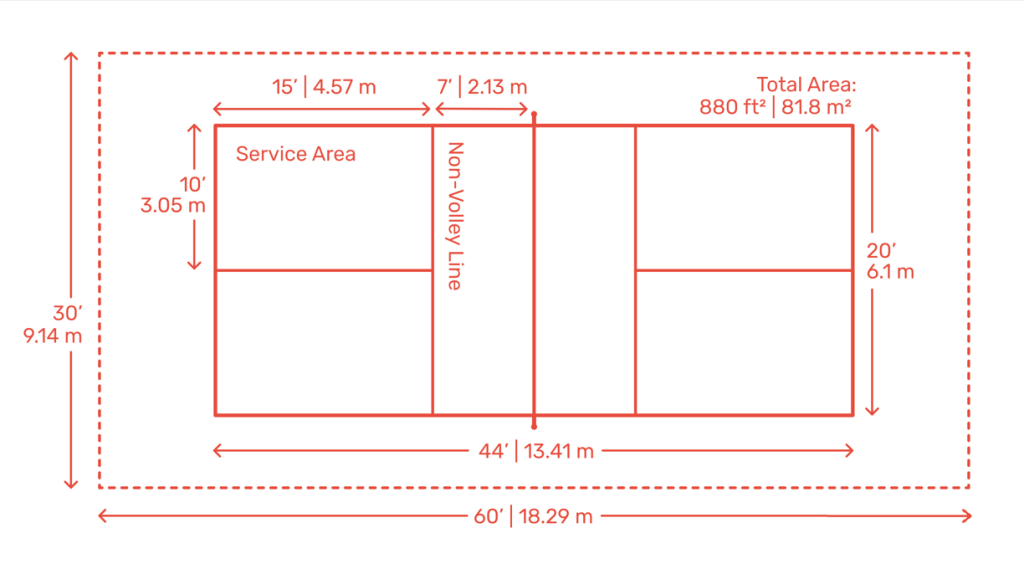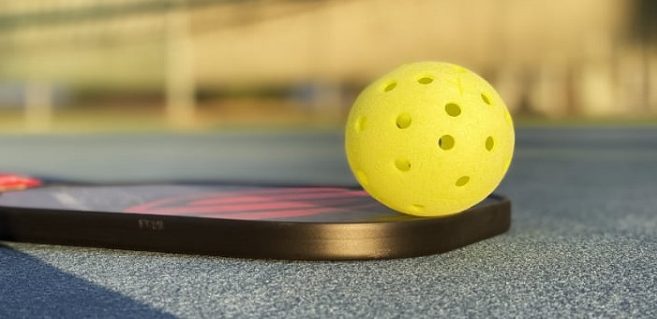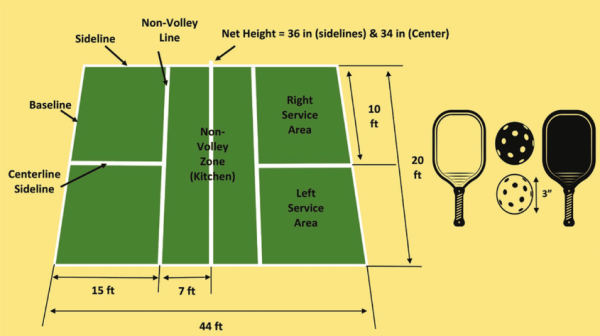The popularity of pickleball has increased significantly in recent years, making it one of the fastest-growing sports in the world. It is crucial to know the correct specifications when laying out a pickleball court. Additionally, if you are setting up an outdoor pickleball court on a court that is oriented normally north/south, you should avoid placing the pickleball courts at right angles to the court.
An equivalent court to a badminton court is available for indoor and outdoor play. There is also a modified tennis net used in pickleball. If you’re an avid pickleball player and wish to learn more about picking out the proper pickleball court, you’re in the right place. Some build their own backyard courts, while others add them to recreation centres. Pickleball courts should consider the surface, color, and other factors when construction.
A pickleball court requires a thorough understanding of every aspect of the project, from the surface to the size.
What are Pickleball Court Dimensions?
The amount of space you have will determine how safely and effectively you can play pickleball. Some people believe that pickleball courts are the same size as tennis courts, but they are not. You will still need plenty of room to settle down and play the game.

A USA pickleball association-approved court will have the following Pickleball Court Dimensions:
- Pickleball Court Dimensions: 20 by 44 feet, suitable for both singles and doubles games
- Height of Pickleball Net: 34 inches in the middle, 36 inches on either side
- Pickleball court size: The standard court size is 30 by 60 feet, but a court of 40 by 64 feet is preferable for tournament play or as a standalone facility.
These are the Pickleball Court Dimensions required for a single court. The area required to build multiple courts will be more significant. A recreation center will need approximately the same space as a tennis court if you plan to build four pickleball courts. You’ll need to look for an area with more open space if the space you have in mind cannot accommodate those dimensions.
The rules of pickleball are constantly evolving, and 2023 will bring some exciting changes to the game. For the latest information on these new rules and how they will affect gameplay, visit our page on Pickleball Rules 2023.
Additional Pickleball Court Accessories
Several items should be considered when building a new pickleball court for the purpose of enhancing your home or facility, said Sport Surfaces:
- The installation of awnings and cabanas over tennis courts, so players can get shade and take a break
- Fountains that contain water
- Your facility should have an open design to attract new players
- Screens for blocking sound on pickleball courts
One of the fastest-growing sports, pickleball can provide avid players and new athletes alike with an excellent opportunity to play. We’re happy to provide you with design and construction assistance for your new pickleball court. Get in touch with us today for more information and to begin construction or conversion of your pickleball court.
What is The Pickleball Court Size?
In terms of court dimensions, pickleball courts should be approximately 20 feet wide and 44 feet long (including lines). Pickleball courts with permanent lines should have 10 feet of extra space outside the court. There should be 2-inch wide court lines that contrast with the primary color of the court. They should also be the same color.

Pickleball courts should be oriented north to south when laying out the layout in your community, school, or city to prevent players from staring directly into the sun. Dimensions of pickleball courts Each side of the court must have three unique areas that must meet specific measurements to be considered an official pickleball court.
Non-volley Zone
As the name suggests, the non-volley zone is 20 feet wide and 7 feet long. It covers the entire court width and stretches exactly seven feet on either side of the net, making it 14 feet long. On both sides of the NVZ, you should paint it a consistent color, but usually, it contrasts slightly with the rest of the pickleball court.
Also Read : How to Play Pickleball For Beginners
Left Service Area
Three main lines form the left service area: the left sideline, the baseline, and the centerline. Additionally, it is located directly underneath the kitchen, but the kitchen lines are not considered part of the service area. Left and right service areas each measure ten feet wide and fifteen feet long.
Right Service Area
The right service area measures 10 feet wide and 15 feet long, with the lines included. It contains the right sideline, the baseline, and the centreline.
During a pickleball match, competing teams routinely switch sides to ensure no team has an advantage based on the court’s sun, wind or other conditions. Like tennis, pickleball courts are symmetrical and have the exact measurements on both sides.
Pickleball Court Size In Feet

Pickleball is played on a court that is similar in size to a doubles badminton court. However, the pickleball court has a no-volley zone that is seven feet long and extends from the non-volley line to the baseline. This zone is not used in tennis. The rest of the court is the same size as a badminton court.
The pickleball court size in feet is 44 feet long and 20 feet wide. The net is hung at a height of 36 inches in the middle of the court. The non-volley line is seven feet from the net. The baseline is at the back of the court.
Pickleball can be played as singles or doubles. In singles, each player uses a paddle. In doubles, each team consists of two players who each use a paddle.
The object of the game is to hit the ball over the net and into the opponent’s court. The opponent must then let the ball bounce before hitting it back. The rally continues until one player or team makes a mistake.
Temporary Court Layouts
Existing courts can be converted to pickleball courts in two ways: shared use and dedicated use. In shared use, pickleball lines are added to existing surfaces, so players of both sports can use them simultaneously. The additional lines may cause some confusion initially, but players soon become accustomed to them.
Make sure that you get proper permission before making any permanent changes to an existing surface. When temporary taped or adhered lines are removed, residue may remain on the court. If permission is granted, test the surface in a small, visible area first.
pickleball court size can be set up on a variety of existing sports surfaces, including basketball, volleyball, badminton, and inline hockey rinks. Tennis courts are most commonly used for shared use.
Portable Net
There is no installation of portable net systems into the ground, as their name implies. Some people prefer to take their net systems with them wherever they go. This is great if you want to have fun and socialize. You are not recommended always to leave your portable net system outside. It would be best if you moved it up and down when necessary. You need to be aware that this can get tiring.
How To Build A Pickleball Ball Yourself?
After picking out the Pickleball Court Dimensions, surface, fencing, lighting, and other materials, it’s time to put them all together. To aid you in the building process, consider the following tips:
- Get the job done by a professional contractor. While installing a pickleball net system may be a simple process if you’re placing a net and painting the surface for just one court for your own yard, hiring a professional contractor can help ensure everything is built and set up to code for recreation centres, clubs, and school pickleball play.
- Orient your pickleball court north-south. In order to maximize your players’ visual awareness, outdoor pickleball courts are generally exposed to mainly environmental factors that can interfere with their vision (position of the sun, shadows cast on the surface of the court, etc.) and therefore it is crucial to orient your pickleball court north-south.
- White 2-inch wide lines should be used on the court. Marker lines can be drawn with sidewalk chalk, contractor’s blue #1 chalk dust, green tape, orange masking tape, or acrylic paint. Pickleball courts usually have the following lines:
- Baselines: Located on either end of the court, they run parallel to the pickleball net.
- Sidelines: There are two pickleball nets on either side of the court, and they run perpendicular to the pickleball net.
- Non-Volley Line: A line running parallel to the net should be placed 7 feet (2.13 m) from the net on both sides of the net between the sidelines.
- Non-Volley Zones: There are three distinct areas of the pickleball court, the non-volley line, two sidelines, and a net separating them.
- Centerlines: A line that runs between the non-volley line and baseline on each side of the net.
- Service Courts: You will run on either side of the centerline, surrounded by the non-volley line, sideline, and baseline.
Follow pickleball court layout guidelines from the USAPickleball Association to ensure that everything is set up according to regulation pickleball standards.

Color the Court
Following that will be the color coatings. In the case of outdoor courts, USAPA recommends using acrylic paint 100 per cent of the time. The USAPA states pickleball courts can be painted any color as long as it contrasts with the lines on the courts. Tennis courts are usually painted blue or green.
A minimum of two coats are typically applied to the color. Due to the smaller court size and the fact that pickleball courts are often used for doubles, Gearheart explained, “there is more wear because players are always scuffing the same little boxes.”. Perhaps adding another coat would be worthwhile.”
The manufacturer will specify the type and amount of silica sand in each gallon. The concentrated resurfaced used by Sports Master uses approximately 14 pounds (6.35 kg) of silica sand of 50-60 mesh. Generally, coloured coatings are applied using rounded and finer sand, between 70 and 90 mesh.
It is preferred that tennis facilities use more angular sand because it will grab the ball and slow down play,” Gearheart said. It is the rounder sand that is used in pickleball, which means the ball is not chewed up as much as it is in racquetball.”
Understanding what is a rally in pickleball and rally scoring in pickleball are essential for new players. A rally refers to the exchange of the ball between opposing teams, while rally scoring awards points to the team that wins each rally.
FAQs: Pickleball Court measurements?
Whenever you use something, some maintenance will inevitably need to be done after some time. The exact length of time your outdoor pickleball court will require attention will depend on the weather conditions and how often it will be used.
It is mostly recommended to resurface a pickleball court every five years. This is when you need to consider resurfacing the pickleball court because resurfacing will prevent you from slipping or falling on it. It may be necessary to resurface your court sooner if it is heavily used.
A pickleball court usually costs between $550 and $700, but it is essential to consider several factors before making a decision. Here are a few of them:
Suitable base type
Substances used for playing
The rest of the materials
Net system
Labour
Time of construction
Whether it’s located on land that someone already owns
The lines on some courts are divided up differently between pickleball and tennis; however, others use one set of lines to play both sports, causing confusion and disagreements as to whether a shot has been made. Pickleball enthusiasts believe that separate lines should be painted on the courts as the sport gains popularity to avoid misunderstandings and ensure a better overall game experience.
To Summarize
As you can see in the diagram below, it is important to know the exact dimensions of your pickleball court, regardless of whether it is temporary (or permanent). There is a common setting for pickleball courts on north-south facing grounds based entirely on their orientation. You should not position the pickleball court at right angles if it meets the north-south orientation of your court. One player may be at risk of serious injury if he or she is playing in the sun too early in the morning or late in the afternoon.



